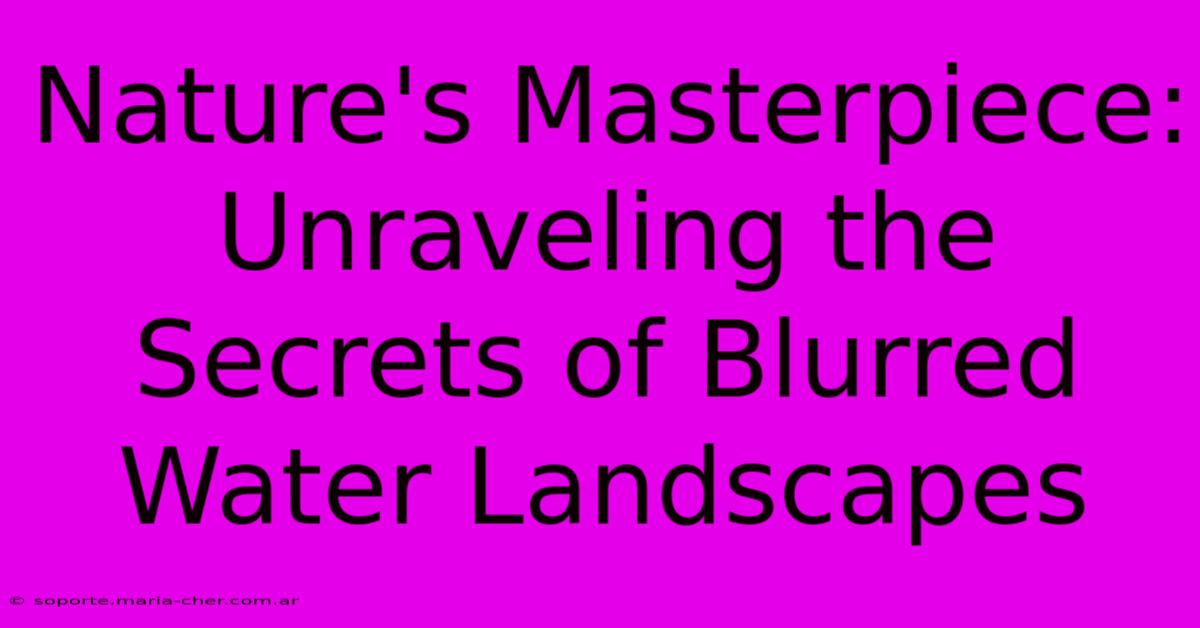Nature's Masterpiece: Unraveling The Secrets Of Blurred Water Landscapes

Table of Contents
Nature's Masterpiece: Unraveling the Secrets of Blurred Water Landscapes
Blurred water landscapes. The very phrase evokes a sense of serenity, mystery, and captivating beauty. From the misty veils of a waterfall to the soft, diffused light reflecting on a tranquil lake, these scenes possess a unique power to draw us in and soothe our souls. But what is it about these images that captivates us so? And how can we, as photographers or simply as admirers, better understand and appreciate this stunning natural phenomenon? This article delves into the secrets of blurred water landscapes, exploring the artistic techniques, the scientific principles, and the emotional resonance behind their enduring appeal.
The Science Behind the Blur
The "blur" in blurred water landscapes is, scientifically speaking, a consequence of motion blur. Moving water, whether a rushing river, a gentle stream, or crashing ocean waves, is captured as a streak or a softened, ethereal form due to the camera's shutter speed. A slower shutter speed allows more light to hit the sensor, resulting in a longer exposure time. This extended exposure time captures the movement of the water, transforming it into a smooth, almost dreamy texture. The longer the exposure, the more pronounced the blurring effect will be.
Understanding Shutter Speed's Role
Shutter speed is arguably the most crucial element in creating blurred water effects. Experimentation is key. A good starting point is to use a shutter speed of 1/2 to 1 second, but the optimal speed will depend on several factors:
- The speed of the water: Faster-moving water will require a faster shutter speed to achieve a desirable blur.
- The amount of light: In low-light conditions, you'll need a slower shutter speed to capture sufficient light, potentially resulting in a more significant blur.
- Desired aesthetic: Do you want a subtly blurred effect, or a dramatically silky smooth texture?
The Artistic Composition of Blurred Water Landscapes
Beyond the technical aspects, the artistic composition significantly impacts the overall effect. Here are some crucial elements:
Leading Lines & Framing
Utilize natural leading lines, such as riverbanks, paths, or tree branches, to guide the viewer's eye through the scene. Clever framing using foreground elements like rocks, foliage, or even a bridge can enhance depth and create a sense of scale.
Light and Shadows
The interplay of light and shadow dramatically affects the mood of your blurred water landscape. The golden hour (sunrise and sunset) often provides the most captivating light, casting warm, evocative hues on the water and surrounding environment. Experiment with backlighting to create ethereal silhouettes and highlight the texture of the water.
Color and Contrast
The color palette of your image is equally important. Muted tones can evoke calmness, while vibrant colors can add energy and drama. The contrast between the blurred water and sharper elements in the foreground or background adds depth and visual interest.
Capturing the Magic: Tips and Techniques
- Use a Tripod: A stable tripod is essential for eliminating camera shake, especially with slower shutter speeds.
- Neutral Density (ND) Filters: ND filters reduce the amount of light entering the lens, allowing you to use slower shutter speeds even in bright conditions. This is crucial for achieving the desired blur.
- Remote Shutter Release: A remote shutter release minimizes camera shake caused by pressing the shutter button.
- Post-Processing: While capturing the perfect image in-camera is ideal, subtle adjustments in post-processing can further enhance the final result.
The Emotional Impact
Blurred water landscapes possess an undeniable emotional power. The soft, flowing lines, the diffused light, and the overall sense of serenity create a visual poetry that speaks to our deepest emotions. They invite contemplation, relaxation, and a connection with the natural world. This evocative quality is a significant part of their enduring appeal.
Conclusion: Embrace the Blur
The beauty of blurred water landscapes lies in their ability to capture the essence of movement and tranquility simultaneously. By understanding the scientific principles and mastering the artistic techniques, we can unlock the potential of these mesmerizing scenes, creating images that are both technically proficient and emotionally resonant. So grab your camera, find your inspiration, and embrace the blur!

Thank you for visiting our website wich cover about Nature's Masterpiece: Unraveling The Secrets Of Blurred Water Landscapes. We hope the information provided has been useful to you. Feel free to contact us if you have any questions or need further assistance. See you next time and dont miss to bookmark.
Featured Posts
-
Say Goodbye To Chipped Nails Unlock The Power Of Dds Long Lasting Formula
Feb 10, 2025
-
National Youngest Child Day Unleashing The Inner Wonder And Joy
Feb 10, 2025
-
Sewing Up Loose Threads The Art Of Clarifying Sew And Sow
Feb 10, 2025
-
Elevate Your Brand With Eye Catching Banner Buzz Business Cards Proven To Convert
Feb 10, 2025
-
The Winning Edge How Coach Chuck Daly Transformed Underdogs Into Legends
Feb 10, 2025
